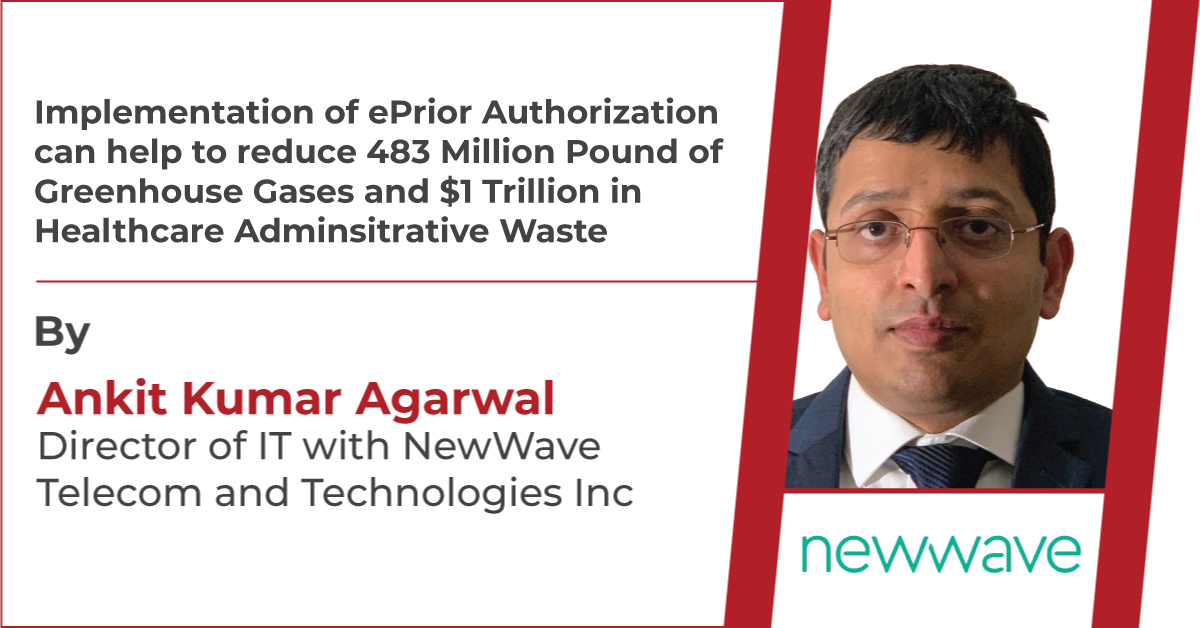
Ankit Kumar Agarwal
Ankit Kumar agarwal is a Wharton Graduate and working as “Director of IT” with NewWave Telecom and Technologies Inc. Ankit is passionate about bringing impactful changes in people’s life and writes blogs to educate people and promote digital Health.
Sounds crazy but what if we can reduce the Green House Gas Emission by 483 million Pound and simultaneously reduce the Healthcare Administrative waste by $1 Trillion in the lifetime of the US Population!!
Problem Statement
United states has approximately 330 million residents. Most of these residents are covered by Health Insurance. It is very common for people to feel under the weather and visit their Primary Care Physicians. At times the Primary Care Physicians need to prescribe specialty medications, which need prior authorization from the Patients Health Plan. Most of the Physicians still use paper based prior authorization process, which leads to paper waste causing Green House gases emission. Prior Authorization process costs Patients $25 per prior authorization requests, causing $13.4 Billion in administrative waste per year.
Can we really save $1 Trillion??
Let us crunch the numbers.
| United States Population | 330 Million |
| Average Life Expectancy | 76 years |
| Yearly Number of Prior Authorizations Per Patient | 4 |
| Lifetime Number of Prior Authorizations Per Patient | =76*4=304 |
| Total Prior Authorizations in 76 years | =330 Million *304 = 100,320 Million |
| Average Number of Pages in each Prior Authorization | 5 |
| Total Number of Prior Authorization Pages used in 76 years | =100,320 Million*5= 501,600 Million Pages |
| 500 pages | 20 Pound Paper |
| 501,600 Million Pages | = 501,600 Million/500=1,003.2 Million Pound Paper = 455 Million Kilogram paper |
| 1000 Kilogram Paper | 942 Kilogram Green House Gases |
| 455 Million Kilogram Paper | 483 Million Pound of Green House Gas Emission |
On top of the Green House Gas Emission, we are talking about $13.4 Billion in Healthcare Administrative waste, which totals up to $1 Trillion over a life span of entire United States population.
HL7 FHIR Electronic Prior Authorization to the Rescue
Is it just a dream or can we actually make this change.
When the internet was in its baby steps, computer systems were required to have their protocols for interacting and reaching the networks as there was no such universal standard on how their systems were different; every time disparate systems needed to communicate with another system, each one needed special software. System developers need specialized and unique software for each server type. For disparate systems to establish the communication channels, new stacks needed to be written for each purpose. These processes often obstruct interoperability when networking is at the initial stage.
The US federal government set up a standard to establish interoperation of the systems. The idea was to ease the flow of network communications across multiple systems, arrive at the right destination, and prevent obstacles in the early networking stage.
Healthcare today is at a similar stage, just like the early internet networking years. Data is the king in almost every business, organization, and entire process flow. When it is seen through the lens of the healthcare industry, data is a backbone for making better clinical decisions, claims to process, and managing critical record systems. When we say critical record systems, it doesn’t always make it easy to share the information between the providers, labs, and payers.
Interoperability is a complex and challenging thing for the healthcare industry today. Different information systems, devices, and applications can access, exchange, integrate, and utilize the data beyond the boundaries to optimize global health needs.
With the introduction of HL7 FHIR Interoperability standards and the direct submission of prior authorization requests from EHR systems using a standard already widely supported by most EHRs – FHIR. To meet regulatory requirements, these FHIR interfaces will communicate with an intermediary who, when necessary, can convert the FHIR requests to the corresponding X12 instances prior to passing the requests to the payer. Responses are handled by a reverse mechanism (payer to intermediary as X12, then converted to FHIR and passed to the EHR). Direct submission of prior authorization requests from the EHR will reduce costs for both providers and payers (Cents comparing to on an average $25 per Prior Authorization Request), get rid of paper waste leading to cut in the Greenhouse Gases. It will also result in faster prior authorization decisions which will lead to improved patient care and experience.
When combined with the Da Vinci Coverage Requirements Discovery (CRD) and Documentation Templates and Rules (DTR) implementation guides, direct submission of prior authorization requests will further increase efficiency by ensuring that authorizations are always sent when (and only when) necessary, and that such requests will almost always contain all relevant information needed to make the authorization decision on initial submission.
Conclusion
Now more than ever, industry stakeholders need to join hands and work collaboratively to quickly finalize the Electronic Prior Authorization Interoperability standards and pave the path for the quick implementation to reduce the 483 million Pound of the Greenhouse Gas Emission and reduce the Healthcare Administrative Waste in the range of $1 Trillion to bring a real change in the life of next generation.
*This article is Peer Reviewed by the Distilinfo Editorial team prior to the publication.*


